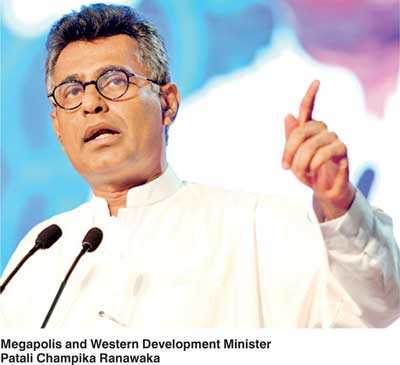Wednesday Jul 02, 2025
Wednesday Jul 02, 2025
Tuesday, 26 June 2018 01:08 - - {{hitsCtrl.values.hits}}
By Charumini de Silva
With Asia’s infrastructure market forecasted to record a 7% - 8% annual growth rate and reach $5.3 trillion market accounting to 60% of the world by 2025, Megapolis and Western Development Minister Patali Champika Ranawaka described Sri Lanka’s Western Megapolis as the grand strategy to propel the country’s drive to achieve the status of a high-income, developed nation by 2030.

Addressing the FIDIC – ASPAC Conference 2018 held yesterday in Colombo, titled ‘Infrastructure Connectivity in the ASPAC Region’, he said the implementation of Western Megapolis will be the grand strategy to eliminate the congestion pressures on urban physical infrastructure on transport, housing, urban services and amenities, and environment, while calling it the ‘key project’ for Sri Lanka to optimally harness the potentials created by the current global techno-economic environment for economic growth.
Ranawaka stressed that the Western Megapolis grand strategy needs to be prudent in the context of global as well as regional geopolitical and economic development.“The world stage is well-set for there-emergence of monsoon Asia as the global economic powerhouse and as the geopolitical theatre of actions, where Sri Lanka is right in the middle of this region. This indicates the potential for Megapolis in South Asia, located in Sri Lanka between Singapore and Dubai,” he added.
According to the Minister, the implementation of Western Megapolis will involve two fundamental transformations that includes the much-needed structural transformation of the economy and the spatial transformation of the Western Region. “The spatial transformation will drive the nation’s grand strategy for overall development in three ways. Firstly, it will enable the national economy to leverage the benefits of economies of agglomeration brought about by urbanisation. Secondly, it will eliminate the congestion pressures on urban infrastructure, urban services and environment brought about by messy urbanisation, and thirdly, it will reduce capital cost of infrastructure provision,” he noted.
Pointing out that there are over 200 different projects already identified for implementation under the Western Region Megapolis, he expressed confidence that the number of projects are bound to evolve as this mega development initiative is evolutionary by its very nature.
“We have grouped these into 10 mega projects. The majority of the development activities are mainlyin functional and partly geographic non-exhaustive categorisation. The first three of them are major infrastructure development projects, the others represent different thematic projects and their combinations,” Ranawaka said.
In terms of becoming the epic centre, or hub, in South Asia, the Minister said that the Government has already identified the Colombo – Trincomalee corridor as the main economic corridor for Sri Lanka in time to come.
“We have developed our national physical plan with one economic corridor connecting the East of our island neighbouring India, Bangladesh, China, East Asia, West Africa, Middle East and Europe.Our aim is to achieve happy citizenry of an economically prosperous, socially equitable nation, given its perfect harmony with the natural environment. We are working towards that dream that can be realised in the foreseeable future,” he pointed out.
Noting that Sri Lanka’s philosophy on development is holistic and inclusive, Ranawaka said it stands on four fundamental pillars, such as economic growth and prosperity, social equity, environmental sustainability and individual happiness.
Towards achieving this four fundamentalsnationally through Western Megapolis,the Ministerlisted out 10 key specific objectives that include achieving the GDP level of a high-income developed country by 2030,to enable structural transformation of the economy, to establish and institutionalise the digital infrastructure, to achieve housing for all by 2030, to achieve self-sufficiency, to achieve 100% green energy beyond 2030, to reduce poverty and unemployment rate to less than 1% by 2030, to provide adequate opportunity for primary, secondary and tertiary vocational and university education in line with the needs of the economic transformation, to make Western Megapolis one of the top 10 most liveable cities in Asia, to ensure environment sustainability and disaster resilience, and to enable high degree of individual happiness amongst citizens.
Discover Kapruka, the leading online shopping platform in Sri Lanka, where you can conveniently send Gifts and Flowers to your loved ones for any event including Valentine ’s Day. Explore a wide range of popular Shopping Categories on Kapruka, including Toys, Groceries, Electronics, Birthday Cakes, Fruits, Chocolates, Flower Bouquets, Clothing, Watches, Lingerie, Gift Sets and Jewellery. Also if you’re interested in selling with Kapruka, Partner Central by Kapruka is the best solution to start with. Moreover, through Kapruka Global Shop, you can also enjoy the convenience of purchasing products from renowned platforms like Amazon and eBay and have them delivered to Sri Lanka.
Discover Kapruka, the leading online shopping platform in Sri Lanka, where you can conveniently send Gifts and Flowers to your loved ones for any event including Valentine ’s Day. Explore a wide range of popular Shopping Categories on Kapruka, including Toys, Groceries, Electronics, Birthday Cakes, Fruits, Chocolates, Flower Bouquets, Clothing, Watches, Lingerie, Gift Sets and Jewellery. Also if you’re interested in selling with Kapruka, Partner Central by Kapruka is the best solution to start with. Moreover, through Kapruka Global Shop, you can also enjoy the convenience of purchasing products from renowned platforms like Amazon and eBay and have them delivered to Sri Lanka.